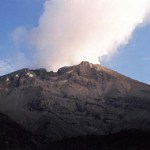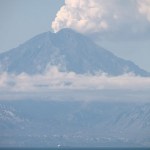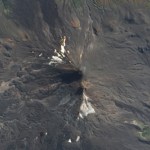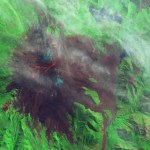Andes
Somehow I haven't posted a bunch of interesting items collected over the last few weeks, so I need to catch up. A pre-emptive hat tip to everyone who has sent me links or notes that might seem familiar in this post.
Tungurahua in Ecuador erupting in 2000.
First off, those of you looking for information on the Haitian earthquake that devastated the capitol Port Au Prince, Highly Allochthonous has post on the tectonics of the quake. Right now, it is hard for me to come up with a worse location in terms of devastation for a quake to have hit in the Caribbean Basin.
Back in volcano news, a lot…
Here it is, my attempt to recap a year's worth of volcanic events. By no means is this supposed to capture every event, but rather the highlight/lowlights and what most captivated me during 2009. I'll be announcing the winner of the 2009 Pliny for Volcanic Event of the Year tomorrow.
Waimangu Geothermal Valley in New Zealand, taken in January 2009 by Erik Klemetti.
January
The year started out with a trip to New Zealand (well, for me at least) and vistas of the Waimangu Valley, formed in the 1886 eruption of Tarawera on the North Island. We were also still thinking about the late 2008…
Before it gets lost in the mists of time/finals, here is the weekly volcano report brought to us by the USGS and the Smithsonian Global Volcanism Program.
Highlights (not including Mayon, Soufriere Hills or Piton de La Fournaise):
Fuego in Guatemala produced ash plumes that reached 4.1-4.7 km / 13,500-15,400 ft along with avalanches of volcaniclastic debris.
Also in Guatemala, lava flows erupted from Pacaya, traveling hundreds of meters from the main vent area.
Manam in PNG produced an 3 km / 10,000 foot ash plume as part of its renewed activity this year.
The lava dome on Nevado del Huila…
Undated image of Cerro MachÃn in Colombia.
I just picked up on this story over on the Volcanism Blog, but I want to post it here too. MachÃn, in Colombia, has experienced a sharp increase in seismicity at the volcano - maintaining the Yellow status for the volcano. 54 earthquakes were recorded at the volcano over the weekend, prompting the INGEOMINAS to raise the alert status. The volcano had a swarm in 2008 that did not lead to any eruption - but remember, better to be safe than sorry. If MachÃn were to erupt, it would join Galeras and Huila as erupting volcanoes in Colombia.
Not much is…
I knew that the minute I said I'd be back to a "regular" posting schedule that I would fail miserably, so maybe the less said, the better.
Cerro Galan caldera in Argentina (taken from space).
Thanks to all the readers who have been avidly discussing a number of fascinating topics over the weekend.
I have seen/read a little bit about the tectonic-forcing mechanism idea for some caldera-style eruptions. The biggest thing to keep in mind is that the caldera-forming event - that is to say the collapse of the roof into the chamber - isn't usually the "trigger" as much as a result of a large…
This week's edition of Wednesday Whatzits could have been called "Miércoles Materia" as all the updates are for South American volcano. Enjoy!
Tungurahua in Ecuador
(Note: all links in spanish)
INGEOMINAS in Colombia is reporting that Nevado del Huila experienced 343 earthquakes over the past week, suggesting that something is brewing at the volcano. This has been accompanied by gas emissions and ash from the fractured dome. The Volcano Observatory in Popayán mentions that more than half of the earthquakes are related to magma moving into the system. Huila remains at Level III (Yellow)…
Here's some news bits for all you volcanophiles. Enjoy the weekend!
Ubinas in Peru steaming away in June 2007. Image courtesy of Eruptions reader Mike Lyvers.
There has been a lot of press lately on the theory that a large eruption from an ancient volcanic field in China (the 260-million-year-old Emeishan volcanic province of southwest China) could be the culprit in the grand Permian extinction. I have to admit, I've only skimmed the surface of this study, but the work lead by Dr. Paul Wignall (a paleontologist, not a volcanologist - not that there is anything wrong with that) seems to…
400-500 years ago in the midst of the Great Dying somewhere the indigenous inhabitants of the New World suffered mortality rates on the order of 90-95%. This was almost certainly due to the facts of evolutionary history; the indigenous peoples had little defense against Eurasian pathogens. A result has been the reality that most of the New World is inhabited by European, African or mixed populations. But there are exceptions. In Mesoamerica there is still an indigenous dominated region from southern Mexico into the highlands of Guatemala. More substantially the highlands of the Andes, and…
Here's the latest news from the USGS and SI Global Volcanism Program. It might not record every little volcanic noise in the world each week, but nothing like getting all the major volcanic events summarized on a weekly basis.
Highlights this week (not including Nyiragongo, Redoubt and Galeras):
The eruption at Rinjani in Indonesia continues, with elevated seismicity and 300-600 meter plumes.
Sporadic strombolian eruptions from the Crater C at Arenal, Costa Rica (since late April)
High seismicity, 100 meter domes and continued dome collapses continue at the two domes growing at Chaiten,…
Redoubt emitting a large steam plume in April 2009. Image courtesy of Calvin Hall.
A few snippets from the world of volcanoes:
The current eruptive cycle at Galeras continues to go strong. Officials with INGEOMINAS, the Colombian Geology Survey, believe the volcano will erupt again in the next few "days to weeks". The volcano last erupted a few weeks ago (in spanish) and caused quite a bit of panic in the city of Pasto at the foot of the volcano. An Orange Alert has been issued (in spanish) for the volcano.
Another volcano have is on the verge of a larger eruption is Nyiragongo in the DR of…
All the eruptions fit to print from the Smithsonsian/USGS GVP Weekly Report.
A few highlights (not including Redoubt, Rinjani and Slamet):
Multiple ash plumes from Galeras (Colombia), some producing noticeable ash fall up to 35 km from the vent.
The Alert Level at Anak Krakatau, Indonesia was raised to 3 (out of 4) after a sharp increase in the number of explosions.
The Alert Level at Cleveland in Alaska was lowered from Yellow to "Unassigned" (no Green for Cleveland as there is no real-time seismic network for the volcano, thus no "background levels" to compare.)
Ebeko in Russia continues…
Some brief tidbits from the volcanic realms:
Active volcanism at NW Rota-1
Kilauea? Explosive? You might think of Kilauea as a volcano that generates impressive Hawaiian-style eruptions with fire fountains reaching 100s m and dazzling lava flows, but Don Swanson at HVO sees evidence of a big explosive event at Kilauea. This eruption was ~1,000-1,600 years ago and may have produced a plinian-scale eruptive column and threw cm-scale chunks up to 17 km from the vent.
The intermingling of life and active volcanism always seems counterintuitive, but when you're talking undersea volcanism, all…
Chaiten erupting in May 2008. Image courtesy of ONEMI.
Speaking of anniversaries, this weekend is the one-year mark for the Chaiten eruption (in spanish) in Chile, the first eruption at the volcano in ~9,000 years. Yes, indeed, the rhyolite eruption that caught most everyone by surprise is still going strong one year later, with two domes growing within the caldera (in spanish). The eruption produced some of the most impressive and sustained ash columns in years (see below) - climbing to 16 km/9 mi, abundant lahars and pyroclastic flows from the emergence and growth/collapse of the domes and…
Well, after lamenting the slow volcano news, things are beginning to pick up again. Beyond the news of a potential increase in activity at Anak Krakatau, there are a few other newsworthy bits that have come up:
Mt. Kerinci in Indonesia
Mt. Kerinci in Indonesia is showing signs of eruption. The volcano is the highest mountain on the island of Sumatra, reaching 3,800 m / 12,400 feet and last erupted in March 2008. Its volcanic activity is marked by small (VEI 2) explosions of ash and tephra. Currently, the volcano is experiencing increased tremors and minor explosions that rained ash on a tea…
It has been rather quiet on the volcano-front in the last week. Redoubt and Llaima (in spanish), after a few weeks of intense eruption, are both back on Orange Alert. News of the eruptions from Hunga Tonga Hunga Ha'apai and Fernandina is rather sparse in the details. The news of volcanism in 2009 seems to have settled down.
A few tidbits I caught over the weekend:
Chaiten
Damage wrought by the eruption of Chaiten on the town of Chaiten in Chile, taken in early December 2008. Image courtesy of the NASA Earth Observatory.
Don't you feel like you're read this sort of story before after other…
The weekend is rolling in and I might end up spending most of it in the 90+ degree California weather, so unless something big comes up (volcanically), I'll leave you with a few news bits.
Llaima
Llaima in April 2009. Image courtesy of the NASA Earth Observatory
This is a true color image of Llaima in Chile, provided by the great folks at the NASA Earth Observatory. You can clearly see the dark grey new tephra on the main summit cone along with the grey ash covering the snow on the southwestern part of the volcano (north is up). A few other fun features are some smaller parasitic cones in…
Just a quick note before I'm off to this ...
Llaima
The SERNAGEOMIN is evaluating whether the alert level at Llaima should be lowered to Yellow in the near future (in spanish). Seismic acitivity at the volcano have come down since the eruptions started a few weeks ago and most of the activity now seems to be fumarolic in nature.
Popocatépetl
Popo (as it is also called) continues to produce steam/gas plumes (in spanish), 5 in one day on Monday of this week. However, all the other usual volcanic monitoring parameters (seismicity and the like) are unchanged according to Cenapred (National…
Fernandina, Ecuador
Fernandina erupting in 2009.
UPDATE 4/13/09 at 12PM: The NASA Earth Observatory has posted a nice MODIS image showing the plume from the Fernandina eruption drifting out over the Pacific.
We have a few more details on the ongoing eruption at Fernandina in the Galapagos Islands. Officials from the Parque Nacional Galápagos (PNG) flew over the island (in spanish) and saw the eruption is coming from a several-kilometer-long fissure vent that flows towards the sea, dividing into multiple flows and then coalescing when it reaches the sea. There is also a lot of vapor being…
Chaiten erupting on January 19, 2009. Image courtesy of the NASA Earth Observatory.
It is hard to believe that we are less than one month away from one-year anniversary of the beginning of the eruption at Chaiten (and with it, the one-year anniversary of this blog!) The volcano in southern Chile is still erupting away, creating at least 2 dome complexes within the older caldera. These domes have been experiencing periodic collapses, creating block & ash flows, some of which have made it out of the caldera and down close to the ghost town of Chaiten. Along with the block & ash flows,…
Llaima in Chile, taken on April 9, 2009. Image courtesy of the NASA Earth Observatory.
The NASA Earth Observatory (currently celebrating its 10th year) has posted a number of great images of the current eruption of Llaima in Chile, taken from Earth Observing-1 and Terra Satellites. They show both the ash plume of the eruption and the lava flows associated with it (above). The image here is a false-color image of Llaima, where the bright red/orange is the lava flow from the volcano, along with the dark brown of the ash/rocks from this and previous eruptions.
The eruption itself might continue…



